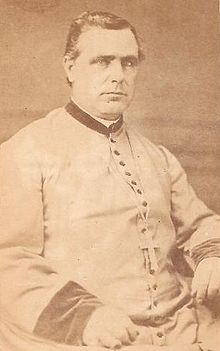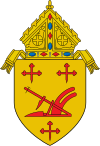Joseph Gregory Dwenger |
|---|
 |
| Born |
(1837-04-07)April 7, 1837 |
| Died |
January 22, 1893(1893-01-22) (aged 55) |
Styles of
Joseph Gregory Dwenger
|
|---|
 |
| Reference style |
The Most Reverend |
| Spoken style |
Your Excellency |
| Religious style |
Monsignor |
Joseph Gregory Dwenger (April 7, 1837 – January 22, 1893) was the Roman Catholic Bishop of Fort Wayne (1872–1893).
Dwenger was born near Minster, Ohio, in 1837. Orphaned at an early age, he was educated by the Fathers of the Precious Blood, entered their community, and was ordained priest 4 September 1859. Appointed professor in the seminary of his community, he filled that position until 1862, and was then assigned to parochial work. From 1867 to 1872 he was occupied in preaching missions.
He was consecrated 14 April 1872. During his time in office he supported the congregation of the Poor Handmaids of Jesus Christ, as had his predecessor Bishop John Henry Luers. He allowed Father Edward Koenig – who had served as advisor to the sisters since their arrival – to remain in office in their Motherhouse in Fort Wayne. The good relationship continued, and in due course the congregation opened many schools, orphanages and hospitals in his and the neighbouring dioceses. Especially the establishment of orphanages were at his core interest.
He served such parishes as Holy Rosary in St. Marys and St. Joseph's in Wapakoneta, both in Auglaize County,[1] and he aided in establishing Immaculate Conception parish in Celina in Mercer County.[2] In 1874 Bishop Dwenger was the head of the first American pilgrimage to Rome. In 1875, he erected an orphan asylum and manual labour school for boys at Lafayette. He was a zealous promoter of the parochial school system. In 1884 he attended the Third Plenary Council at Baltimore. The following March he was deputed, with Bishops John Moore and Richard Gilmour, to present the decrees of the council to Pope Leo XIII. In 1886, he erected an asylum for orphan girls at Fort Wayne. In 1888 when he was on his way to Rome he visited the German Motherhouse of the congregation of the Poor Handmaids of Jesus Christ in Dernbach Westerwald from where their community took its beginnings. He stated his intention as to express personally his gratitude for the many services which had been done for the development of his diocese and the many sisters which had been sent to serve in the US.
As in 1888, in 1891 he again went to Rome, the last time in the interest of the Pontifical North American College. Soon after his return he fell ill, and died on 22 January 1893.
Bishop Joseph's parents were Johann Gerhard Heinrich "Henry" Dwenger, who died in German Twp., Auglaize County, Ohio, in 1840 (at the time German Twp. was in Mercer County), and Maria Catherine Wirdt, who moved to Cincinnati shortly after Henry died, where she lived for several years, but returned to Mercer County, where she died in October 1849. Bishop Joseph had 2 older brothers Heinrich F. Dwenger and Herman Dwenger. The parents and 2 older sons arrived in Baltimore harbor August 25, 1834, on the ship Cassander.
Joseph Gregory Dwenger is the namesake for Bishop Dwenger High School in Fort Wayne.
References
^ McMurray, William J., ed. History of Auglaize County Ohio. Vol. 1. Indianapolis: Historical Publishing Company, 1923, 324.
^ "Mercer County, Ohio History 1978." Celina: Mercer County Historical Society, 1978, 525.
Catholic Church titles
|
|---|
Preceded by
John Henry Luers
|
Bishop of Fort Wayne
1872–1893
|
Succeeded by
Joseph Rademacher
|
This article incorporates text from the 1909 Catholic Encyclopedia article "Fort Wayne" by Bonaventure Hammer, a publication now in the public domain.
Roman Catholic Diocese of Fort Wayne–South Bend
|
|---|
| Bishops |
- Ordinaries
- John Henry Luers
- Joseph Gregory Dwenger
- Joseph Rademacher
- Herman Joseph Alerding
- John F. Noll
- Leo Aloysius Pursley
- William Edward McManus
- John Michael D'Arcy
- Kevin C. Rhoades
- Auxiliary bishops
- Joseph Robert Crowley
- John Richard Sheets
- Daniel R. Jenky
|
|
| Churches |
- Cathedrals
- Cathedral of the Immaculate Conception, Fort Wayne
- St. Matthew Cathedral, South Bend
- Basilica
- Basilica of the Sacred Heart, Notre Dame
- Parishes
- St. Mary of the Assumption Church, Avilla
- St. Mary's Catholic Church, Huntington
- St. Adalbert Church, South Bend
- St. Casimir Church, South Bend
|
| Education |
- Higher education
- Ancilla Domini College, Donaldson
- Holy Cross College, Notre Dame
- Saint Mary's College, Notre Dame
- University of Notre Dame, Notre Dame
- University of Saint Francis, Fort Wayne
- High schools
- Bishop Dwenger High School, Fort Wayne
- Bishop Luers High School, Fort Wayne
- Marian High School, Mishawaka
- St. Joseph High School, South Bend
|
| Priests |
- John George Bennett
- John Paul Elford
- Andrew Gregory Grutka
|
| Miscellany |
|
 Catholicism portal Catholicism portal
|
Roman Catholic Archdiocese of Cincinnati
|
|---|
Ordinaries of the Archdiocese of Cincinnati
|
|---|
| Bishop |
|
|
| Archbishops |
- John Baptist Purcell
- William Henry Elder
- Henry K. Moeller
- John T. McNicholas
- Karl Joseph Alter
- Paul Francis Leibold
- Joseph Bernardin
- Daniel Edward Pilarczyk
- Dennis Marion Schnurr
|
 Catholicism portal Catholicism portal
|
|
Churches in the Archdiocese of Cincinnati
|
|---|
| Cathedral |
- Saint Peter in Chains Cathedral
|
|
| Parishes |
- Cincinnati:
- Church of the Annunciation
- Immaculata Church
- Old St. Mary's Church
- St. Aloysius on the Ohio
- St. Francis De Sales Church
- Saint Francis Seraph Church
- St. Francis Xavier Church
- St. Lawrence Church
- St. Pius X Church
- St. Rose Church
- Dayton:
- Holy Cross Church
- Sacred Heart Church
- St. Adalbert Church
- St. Mary's Church
- Springfield:
- St. Joseph's Church
- St. Raphael's Church
- Other:
- Immaculate Conception Church, Botkins
- St. Aloysius Church, Carthagena
- Nativity of the Blessed Virgin Mary Church, Cassella
- Immaculate Conception Church, Celina
- Precious Blood Church, Chickasaw
- Our Lady of Victory (Cincinnati)
- St. Joseph's Church, Egypt
- Holy Family Church, Frenchtown
- St. John's Church, Fryburg
- St. Patrick's Church, Glynwood
- St. John the Baptist Church, Maria Stein
- Sacred Heart Church, McCartyville
- St. Michael's Church, Mechanicsburg
- St. Augustine's Church, Minster
- St. Louis Church, North Star
- St. Nicholas Church, Osgood
- St. Anthony's Church, Padua
- St. Remy's Church, Russia
- St. Henry's Church, St. Henry
- Holy Rosary Church, St. Marys
- St. Rose's Church, St. Rose
- St. Sebastian's Church, Sebastian
- St. Joseph's Church, Wapakoneta
|
| Former parishes |
- All Saints Church, Cincinnati
- Holy Trinity Church, Cincinnati
- St. Augustine Church, Cincinnati
- St. George's Church, Cincinnati
- St. Michael the Archangel Church, Cincinnati
- St. Paul Church, Cincinnati
- St. Philomena's Church, Cincinnati
- St. Patrick's Church, St. Patrick
|
| Shrine |
- Shrine of the Holy Relics
|
|
Education in the Archdiocese of Cincinnati
|
|---|
| Higher education |
- Chatfield College
- University of Dayton
- Edgecliff College
- Mount St. Joseph University
- Xavier University
|
|
| Seminary |
- Athenaeum of Ohio – Mount St. Mary's Seminary of the West
|
| High schools |
- Cincinnati
- DePaul Cristo Rey High School
- Elder High School
- La Salle High School
- Mercy McAuley High School
- Archbishop McNicholas High School
- Purcell Marian High School
- Seton High School
- St. Ursula Academy
- St. Xavier High School
- Summit Country Day School
- Ursuline Academy
- Dayton
- Carroll High School
- Chaminade Julienne High School
- Other
- Archbishop Alter High School, Kettering
- Father Stephen T. Badin High School, Hamilton
- Catholic Central School, Springfield
- Bishop Fenwick High School, Franklin
- Lehman Catholic High School, Sidney
- Moeller High School, Kenwood
- Mount Notre Dame High School, Reading
- Royalmont Academy, Mason
- Roger Bacon High School, St. Bernard
- St. Rita School for the Deaf, Evendale
|
|
Clergy of the Archdiocese of Cincinnati
|
|---|
| Auxiliary bishops |
- Sylvester Horton Rosecrans
- Joseph H. Albers
- George John Rehring
- Paul Francis Leibold
- Edward A. McCarthy
- Nicholas Elko
- Daniel Edward Pilarczyk
- James Henry Garland
- Carl K. Moeddel
- Joseph R. Binzer
|
|
| Priests |
- John Martin Henni
- Edward Fitzgerald
- Clarence George Issenmann
- Henry Damian Juncker
- Joshua Maria Young
- John Baptist Lamy
- James Frederick Wood
- John Henry Luers
- Caspar Henry Borgess
- Richard Gilmour
- John Quinlan
- Augustus Toebbe
- Joseph Gregory Dwenger
- Henry Richter
- Francis Beckman
- Urban John Vehr
- Francis Augustine Thill
- Anthony John King Mussio
- John Joseph Kaising
- Robert Daniel Conlon
- Michael William Warfel
|
|
| Miscellany |
- The Catholic Telegraph
- Der Wahrheitsfreund
- Former St. Charles Seminary
- Gruenwald Convent
- Minster Elementary School
- St. John Cemetery, Cincinnati
- New St. Joseph Cemetery, Cincinnati
- Old St. Joseph's Cemetery, Cincinnati
|
 Catholicism portal Catholicism portal
 Cincinnati portal Cincinnati portal
|
Authority control 
|
- ISNI: 0000 0000 3157 813X
- LCCN: n95013670
- SNAC: w6zw2tgf
- VIAF: 55855009
- WorldCat Identities (via VIAF): 55855009
|






